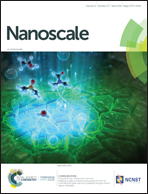Fly-through synthesis of nanoparticles on textile and paper substrates†
Abstract
The fast and efficient synthesis of nanoparticles on flexible and lightweight substrates is increasingly critical for various medical and wearable applications. However, conventional high temperature (high-T) processes for nanoparticle synthesis are intrinsically incompatible with temperature-sensitive substrates, including textiles and paper (i.e. low-T substrates). In this work, we report a non-contact, ‘fly-through’ method to synthesize nanoparticles on low-T substrates by rapid radiative heating under short timescales. As a demonstration, textile substrates loaded with platinum (Pt) salt precursor are rapidly heated and quenched as they move across a 2000 K heating source at a continuous production speed of 0.5 cm s−1. The rapid radiative heating method induces the thermal decomposition of various precursor salts and nanoparticle formation, while the short duration ensures negligible change to the respective low-T substrate along with greatly improved production efficiency. The reported method can be generally applied to the synthesis of metal nanoparticles (e.g. gold and ruthenium) on various low-T substrates (e.g. paper). The non-contact and continuous ‘fly-through’ synthesis offers a robust and efficient way to synthesize supported nanoparticles on flexible and lightweight substrates. It is also promising for ultrafast and roll-to-roll manufacturing to enable viable applications.



 Please wait while we load your content...
Please wait while we load your content...